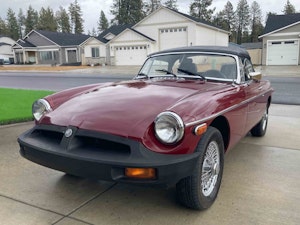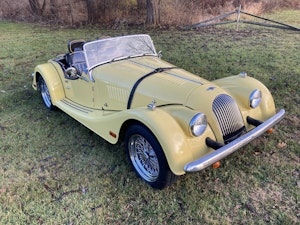Media | Articles
The Color of Monotony
As I sat waiting to turn left at a busy intersection, I noticed the five late-model cars across from me only because all of them were white. I looked around; every car waiting or whizzing through the intersection for a full minute was white, black, gray, or silver. Suddenly, a red Toyota Highlander appeared, and it stood out like Jessica Rabbit in a nunnery. The 1973 Land Rover in which I was trundling to the local cars and coffee is painted a yellowish tan known as Limestone. In those days, black was for limos and hearses and white was mainly for meat wagons and plumber’s trucks. How things have changed.
The auto industry spends hundreds of millions every year trying to get you frothed about their new cars. Is it working? If not, maybe one reason is that they’ve gone completely colorblind. Lately, the salespeople sliding purchase contracts across their desks—some of them binding people to 72 months of payments—can only offer a car painted to look like coal ash, pencil lead, or fat-free milk.
Ironic in a universe that is intensely colorful. The light spectrum gifts us with a rainbow (literally) of vivid hues, but everyone seems to have forgotten old ROY G BIV in their modern race to be utterly invisible. The industry started this way, with the famously thrifty Henry Ford supplying any color you wanted as long as it was black. However, it nearly put him out of business in the late 1920s as other carmakers, notably GM, began painting with broader palettes. By 1955, Cadillac alone offered 20 choices, from
Bahama Blue to Tangier Tan to Pacific Coral, evoking a seductive life of exotic luxury. The psychedelic ’60s with its Lemon Twists, Grabber Greens, and Vitamin Cs turned every Safeway lot into a festive bag of Chiclets. The 1970s and ’80s had vinyl disco stripes.

Contrast that with today, when one of the market’s bestsellers, the Tesla Model 3, is offered in exactly one standard color: Stealth Grey. It’s basically the color of late winter, of cloud butt. It doesn’t make you yearn to drive so much as hunker inside with a book. Tesla charges $1000 for white, $2000 for red. You’d think a company that can afford to pay its leader $56 billion could comp its buyers a few decent colors. But Tesla is hardly alone in squeezing the color-starved for cash. Take the Porsche 911 Carrera, the $122,095 base price of which somehow affords only two standard colors: white and black. Gray and silver at $830 each are the first rungs in a steep upcharge ladder that reaches all the way to $31,070 for custom paint.
Marketplace
Buy and sell classics with confidence
Noteworthy standouts: Hyundai, Kia, and Subaru, with some attractive greens, blues, and coppery bronzes. VW’s new ID.Buzz gets props for its pretty two-tones. But if you’re seeing less color these days, blame both consumer tastes and cost-cutting. People like white; it is guaranteed anonymity. People like silver; it never looks dirty even when it is. People like black, I guess because it wears its stone chips and swirl marks like combat medals. The industry builds what it thinks it can sell, and dull, non-polarizing colors sell.

It also tries to save money with fewer variations. Any additional color must be rigorously tested for paint-ability and durability. Painting a car to today’s standards of quality and reduced environmental impact involves a laborious dance of robots in hermetically sealed clean rooms spraying fussy but nontoxic waterborne paint, which is cured by time-consuming soaks in drying ovens. The paint shop is the most expensive part of any auto plant, and it’s the choke point, too; typically, a factory’s output is dictated entirely by how many cars it can push through its paint shop. Offering lots of choices only slows things down. For example, pearl coats cost extra because the car must be painted twice, meaning it’s taking the place of another car on the line. Figuring out which colors to paint in what percentages is a potentially expensive guessing game. And less risky if you cut the choices and go with the old standbys.
Which raises a chicken-egg question: Do people actually prefer white, black, gray, and silver, or do they buy these four horsemen of the color apocalypse simply because that is what is available? A bit of both, perhaps. But if you take an older car in one of those gorgeous historic hues and repaint it in one of the above, you are committing a crime.
This story first appeared in the March/April 2025 issue of Hagerty Drivers Club magazine. Join the club to receive our award-winning magazine and enjoy insider access to automotive events, discounts, roadside assistance, and more.














Mrs. Tinkerah’s daily is such a common model sedan, all of which seem to be the same color (it’s a hand-me-down, she wouldn’t have chosen it) that we can both lose it in any busy parking lot.
Sadly, most modern cars are so ugly that standout colors just make them look even worse. Colors that looked great on cars in the 50s, 60s, and 70s would look silly at best on most modern vehicles.
Black, white and silver are also the “colors” that kitchen appliances come in. For most people today, cars are just another appliance.
Sad but true.
I’ve been to the Wellborn Museum and that Barracuda is really cool. I bought the coffee mug that they sell with a photo of the car on it. I’m drinking my coffee out of it right now. My favorite colors on it are the aqua in the middle of the door and the B5 blue on the front fender. I never really liked all of the non-colors of the last 30 years. Black paint on cars is only perfect in the showroom, after that day, you can find something wrong on every panel. Our company vehicles were always white, so I never wanted a white vehicle for that reason. Although, I do have a white Corvette, but the torch red interior makes up for it.
Car colours today are boring. All my older cars are interesting. I have four reds, 3 gen 4Runner, 1 st gen Miata, 2003 Pro5 and a Chilli Red 05 MINI Cooper with the required white roof and hood stripes. Add to that a Harvest Gold MGB and a British Racing Green B/GT. Shameful how they don’t do that anymore, just another reason to not buy new.
Ugh. Couldn’t agree more. I already live in the upper midwest, so grey is the depressing color of interminable winter sky. I currently ONLY look at models that offer a blue or green (maybe red family). That currently leaves me with three to four choices of manual drivers. I’m about to bite on the Cadillac CT-4 Blackwing largely because it’s manual, fast, offers a sunroof and a beautiful Typhoon Green. Obviously, a car I have to order. Only other choices are another Mustang, an Acura Integra Type R or a Honda Civic Type S.
The color range is miserable. I’ve commented about it to anyone who would listen but it doesn’t seem to make an impression. That’s one reason my go to (a 1965 Corvair, LS V8) is painted Atomic Orange, a Corvette color.
The shame of it is the manufacturers have the capability to do spectacular colors if they want to. I was at a cars and coffee earlier this year where hot rod with a 30 year old beautiful candy/metallic red House of Color paint job was parked near a Lexus LC500 in metallic red. The Lexus was every bit as gorgeous as the custom paint job (and probably more durable).
Greige, I like that description. For our new 911t, we didn’t want red or any of the 50 shades of German grey, Irish Green wasn’t available at that point (Porsche had suspended PTS), then we thought; “go big or go home”. We went with Ruby Star! Harkens back to the 964RS and Porsche folks get it.
Well I do have two white cars in a 1972 AMC Ambassador Brougham wagon and a 1973 Dodge Polara Spring Special. After that my three daily drivers are green, blue, and red. Three other classics are green, one is pebble beige and one is light saddle. My wife’s 2018 Mazda 3 is gray simply because her model was not the high option version so there were few to pick from.
The more exciting a vehicle is, the more colorful it should be. Grey minvan = fine. White sportscar = no thanks.
I was at a show yesterday – about 200 cars – and they gave out only ONE trophy: the organizer’s favorite purple car (there were three there)! Maybe we just need to give some encouragement (enticement) to folks to field cars with some “pizazz” colors.